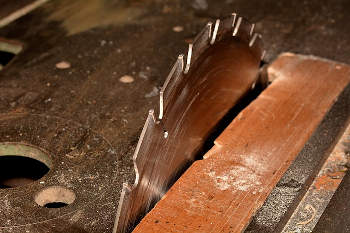
You want cuts that are clean and crisp. Tearout is most likely when making crosscuts, or cuts across the grain. Being proactive about reducing and eliminating tearout is an easy way to save yourself some time when it comes to finishing the wood. Preventing tearout is easy if you take a few extra steps before making the cut.
Here are a few ways to prevent tearout:
- Score the cut line with a razor blade. You are essentially pre-cutting the surface of the wood where tear out is likely.
- Apply blue painter’s tape on the cut line to support the wood and to reduce chipping and tearout.
- Make sure your blade is clean and sharp, and is the right type for finish cuts. A higher tooth count blade will usually work better than a lower tooth count blade in preventing tearout, and just giving you a nice clean cut in general.
- Support the material being cut on all sides. You’re not giving the wood anywhere to flex and put uneven strain on itself during cutting.
- Make the cut slowly to minimize wood removal. Don’t rush the cut. The slower you make the cut, the better the finish will likely be. Keep in mind that slow cuts increase the chances of burning the wood.
- Cut from the bottom to the top of the material. Tearout will occur where the blade initially touches the material. If you cut from the bottom, or the side that will not be visible, you will not have to worry about tearout on the face side. Check which way the saw blade is spinning so you are certain which side is the bottom. A circular saw spins in the opposite direction than a miter saw or table saw, and cuts from bottom to top.
- Use a sacrificial board clamped on top of the material you are cutting. This prevents the wood from having any direction to chip. Similar to applying blue painter’s tape to the cut line, except this works better.
- Use a zero clearance insert. Just like using a sacrificial board, except a zero clearance insert can be used many times over.

You can use most of these together to eliminate chances of tearout. Being familiar with the material you are working with goes a long way to achieving a clean finish and preventing tearout. Knowing how a type of wood will react in certain situations will help you achieve those nice, clean cuts.
Read our tips for picking the right saw blade and for other tips on getting the right cut. Keep yourself out of harm’s way, click here for ways to prevent injuries when using a table saw.
